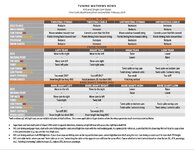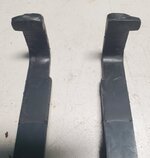Mighty Mouse
WKR
It's not reasonable to expect a rest manufacturer to tell you exactly where to set the rest on a given bow. Dozens of new bows are released every year and each one can be set up in a variety of ways. A Hamskea is probably the most adjustable rest on the market; they give you more than enough adjustment options to make their rests work on pretty much any bow.It does bother me (I'm an engineer) that there isn't a Hamskea "spec" for zeroing out the rest (i.e., "with these settings on a brand X bow, you're good to go").
The Berger hole is 5/16" in diameter and an arrow shaft is around 1/4" in diameter, so there's a roughly 9/16" vertical range through which some part of the arrow is passing thorough some part of the Berger hole. I typically start with center of the arrow shaft through center of Berger hole, but it doesn't bother me one bit if I end up a little above or below that. You find where the bow "wants" the nocking point and rest elevation through trial-and-error by shooting, studying paper tears/bareshaft POI/broadhead POI, then making adjustments. Note that cam timing (as well as nocking point location and rest elevation) can affect a bow's vertical tune.It also bothers me (like I said, I have an "attention to detail" to put it nicely) that there isn't a perfect/correct way for the arrow to pass through the berger hole. It seems like some bows like the arrow "riding on top". How do I know if my bow wants the arrow to pass exactly through the hole versus a little high? Is that a function of what diameter arrow you are shooting (if it matters, I'm shooting a 5mm arrow)?
There's nothing wrong with that "default" setting. There's also nothing wrong with changing it.If I look at Hamskea's own instructions, it seems like (by default) things are set up to have the arrow riding on top of the berger hole. See the first photo. I'm picturing an arrow in the fork of the rest. It would be (unless my eyes deceive me) riding on top of the berger hole.
No, there's nothing wrong with having the nock slightly above (or below) level. If it tunes, it tunes.Basically, the arrow appears to be slightly high of the berger hole and on a downward angle. I hope to pick up a T square (along with the d loop material and pliers that have been mentioned) here soon to quantify how much nock high or low I am at currently. Is anything here necessarily "wrong" (I especially ask because the current tune yields a bullet hole in paper)?
Yes, that's a reasonable plan. Remember that (for comparison to spec) ATA should be measured with the limb bolts fully tightened. If ATA measures long, adding twists to the cables will shorten it.I think my plan is to address the ATA (and likely the poundage) being off first (get the bow back to specs). From there, get the rest to where it's happy in terms of berger hole location with the T square (arrow bottom through the berger hole?). Then, tie my new loop at level or slightly (say a 1/16th) high. Does that sound like a reasonable plan?
I'm an engineer as well with strong perfectionist/OCD tendencies, but remember that every measurement has a tolerance. The looseness of the tolerance on acceptable rest/nocking point positions may offend your sensibilities, but that doesn't mean any deviation from your preconceived (and ill-conceived) notion of where "zero" should be is an actual problem. Also remember that shooter-related factors (e.g., grip pressure, facial pressure, anchor point, etc) can affect how a bow tunes.


